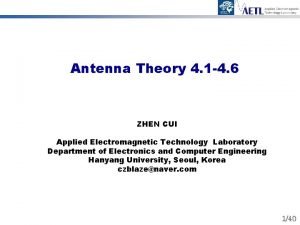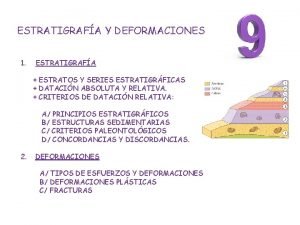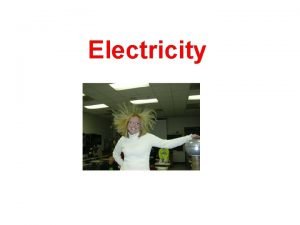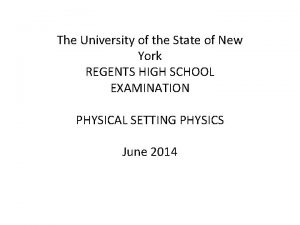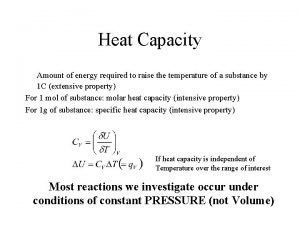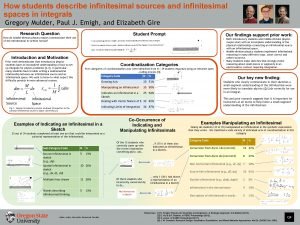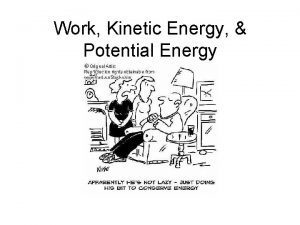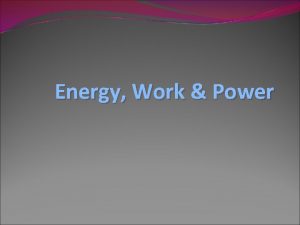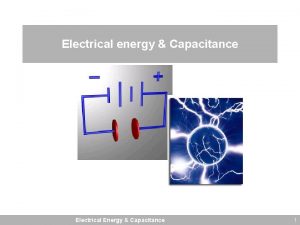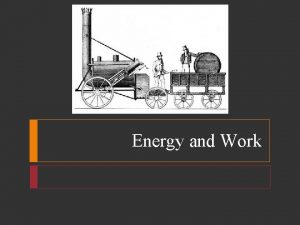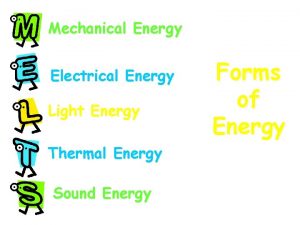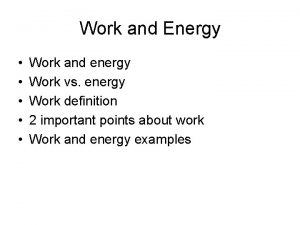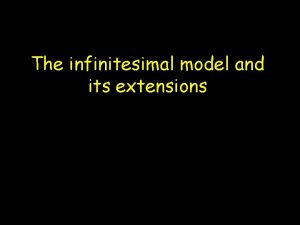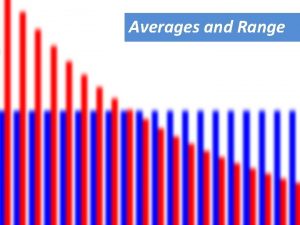Energy and Work The infinitesimal amount of electrical













- Slides: 13

Energy and Work The infinitesimal amount of electrical work, dwelect, is defined as the infinitesimal change in amount of charge, d. Q, moving through some electric potential Since electric potential has units of V and charge has units of C, shows that the unit for work is joules. Now that we are considering a new kind of work, we must remember to include this as part of the total change in internal energy under the first law of thermodynamics. Electrical work in this chapter. Electrical work is performed by the movement of electrons, which are the charged particles that move around in the course of chemical reactions. 1

One of the properties of a single electron is that it has a specific charge, about 1. 602 10 -19 C. This value is symbolized by the letter. In molar quantities, e. NA (NA = Avogadro’s number) equals about 96, 485 C/mol. This quantity is called Faraday’s constant (in honor of Michael Faraday) and is symbolized by F. Ions that have a positive charge of +z therefore represent z. F of positive charge per mole of ions, and ions having a negative charge of z represent –z. F of negative charge per mole. The infinitesimal change in charge d. Q is related to the infinitesimal change in moles of ions, dn (where n is the number of moles of ions). 16. 9. 2021 2

Substituting this expression for d. Q into equation 8. 8, the infinitesimal amount of work is For multiple ions, the amount of work required to change the number of charged species labeled with an i subscript is a system where there is a transfer of charge, the number of species having any particular charge is changing, dni is not zero. If we want to consider the infinitesimal change in G, we have to modify the natural variable equation for G, to include the change in work due to the electric charges. 3

Under conditions of constant temperature and pressure, this equation becomes 16. 9. 2021 4

which can be rearranged algebraically because both of the sums are summing over the same index (the component i) and the same variable (the change in amount, dni): is called the electrochemical potential, rather than the chemical potential. 5

Species A is being oxidized; the general chemical reaction can be represented as The overall chemical reaction is the ni values are positive for the reactants and negative for products, 6

Therefore, the expression must also be a constant for the reaction. We define the electromotive force, E, as the difference between the reduction reaction’s electric potential and the oxidation’s electric potential: Because of volts. values are expressed in units of volts, electromotive forces are expressed in units 7

It is the chemical potential of the products minus the chemical potential of the reactants. This equals the change in the Gibbs free energy of the reaction, Under standard conditions of pressure and concentration, this is This is the basic equation for relating changes in electric potential with changes in energy. This equation also takes advantage of the definition that The variable n represents the number of moles of electrons that are transferred in the balanced redox reaction. 8

Electromotive Force and Equilibrium Constants The most well-known relationship between E and E° is the Nernst equation, derived by the German chemist Walther Hermann Nernst. Having recognized the validity of the following two equations: Solving for E, the nonstandard electromotive force In the Nernst equation. Recall that Q is the reaction quotient 9

The relationship between the equilibrium constant and the EMF of a reaction is commonly used to make measurements on various systems, by measuring the voltage across electrochemical cell. Using the relationships we can easily combine these two equations and derive the expression 10

This expression can also be derived from the Nernst equation by considering the following: at equilibrium, E = 0 (that is, there is no potential difference between the cathode and the anode). But also at equilibrium, the expression Q is exactly the equilibrium constant K for the reaction. Therefore, the Nernst equation becomes The relationship between E and the reaction quotient Q has a practical use in modern analytical chemistry. Consider the standard reduction reaction for hydrogen Its defined E° is zero, but at nonstandard conditions of concentration, E for this half-reaction will be determined by the Nernst equation since E° is zero: 11

16. 9. 2021 12

Thus, the reduction potential of the hydrogen electrode is directly related to the p. H of the solution. What this means is that we can use the hydrogen electrode, coupled with any other half-reaction, to determine the p. H of a solution. The voltage of the electrochemical cell that is made by the proper combination of such half-cells is given by the combination of the two E values of the reactions. 13
 Infinitesimal distance
Infinitesimal distance Trabajo infinitesimal
Trabajo infinitesimal Infinitesimal distance
Infinitesimal distance Estratos concordantes y discordantes
Estratos concordantes y discordantes Chapter 4 work and energy section 1 work and machines
Chapter 4 work and energy section 1 work and machines Power formula
Power formula How to convert mechanical energy to electrical energy
How to convert mechanical energy to electrical energy How do motors work
How do motors work Physics 03-02 potential energy and conservative forces
Physics 03-02 potential energy and conservative forces Section 2 describing energy (continued)
Section 2 describing energy (continued) Energy energy transfer and general energy analysis
Energy energy transfer and general energy analysis Energy energy transfer and general energy analysis
Energy energy transfer and general energy analysis Which graph best represents the greatest amount of work
Which graph best represents the greatest amount of work The amount of energy required
The amount of energy required


